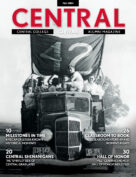Sadly, many hospitalized children can’t get up and dance. That’s what inspired Dance Marathon, a nationwide fundraiser that takes place every year at colleges and high schools to raise money for Children’s Miracle Network Hospitals. For the past three years, Central has held events of its own, raising thousands of dollars for its local Children’s Miracle Network Hospital: the University of Iowa Children’s Hospital.
This year’s event, held March 3, was coordinated by seniors Megan Gray, Amy Schmitt and Emily Sullivan, co-presidents of the Central Volunteer Center.
“One of the mottos of Dance Marathon is ‘we dance for those who can’t,’” says Sullivan.
The event calls for participants to come to a six-hour marathon during which both caffeine and sitting are strictly forbidden. Instead, they dance, play games and otherwise stay on their feet as a show of solidarity for kids who are unable to do the same. Participants are joined by local children who are receiving long-term care in Iowa City. The kids and their families are invited to partake in the activities—though the young ones are perfectly welcome to take a seat when they get tired.
“We try to make it for the kids,” says Gray. They do that with hourly themes—game show, superhero and jungle, for example. “The event is very high-energy and fast-paced,” says Sullivan. “We want to make it a very positive environment.”
In advance of the event, participants fundraise to support their six hours of non-stop movement. Each person is encouraged to raise $100. This year, Central’s marathon raised more than $7,500. Since its founding in 1991, nationwide Dance Marathon events have raised more than $50 million for Children’s Miracle Network Hospitals.
“It’s not only a great cause, but it’s a fun thing to do,” Gray says. Sullivan agrees. “The kids are always so excited to come. It’s good for Central to be involved in the community. They do a lot for us, and it’s important we give back.”
Planning began in the fall when the duo set the date for the event and began to recruit participants. After returning from winter break they established the schedule, created themes and otherwise organized logistics. The two agree the most difficult part was educating potential participants. Since the event is relatively new to campus, many students aren’t familiar with its purpose.
Despite the hard work, they both say the event is more than enough payoff. Every year, the kids are excited to spend time with college students and have some fun. That makes it worth it. “The soreness you feel when you’re done is only a fraction of what these kids go through,” Gray says. But that doesn’t mean she can’t look forward to sitting down. “When it’s all done you just melt into your chair with a smile on your face.”













To encourage serious, intellectual discourse on Civitas, please include your first and last name when commenting. Anonymous comments will be removed.
Comments are closed.